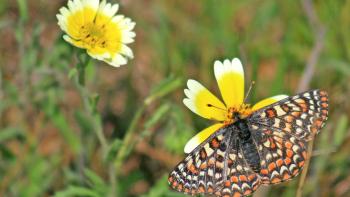Máyyan ‘Ooyákma’s Rare Serpentine Soils: An Enchanting Find in the Bay Area

Many plants, as well as the animals that depend on them, find it extremely challenging to thrive on serpentine soils. This is due to the lack of essential nutrients and water, coupled with the harmful toxins that most plants are unable to tolerate. The few plants that manage to survive under these harsh conditions are often smaller than they otherwise could be with more available nutrients. But there’s one place in the Bay Area where rare species of plants and wildlife thrive amongst undisturbed serpentine grasslands, and that’s Máyyan ‘Ooyákma – Coyote Ridge.

What is serpentine habitat?
Serpentine landscapes are characterized by the presence of serpentine rock, which originates from the depths of the earth's mantle and has been thrust upwards by the relentless forces of tectonic activity spanning millions of years. This peculiar green-hued and waxy rock forms a gritty layer of soil, devoid of essential nutrients, creating an inhospitable and challenging environment for the majority of plant species.
Amidst this unforgiving terrain, some plants, like the Santa Clara Valley dudleya have evolved over millennia to thrive in this inhospitable soil, turning its poor quality into their niche specialty. Every spring, the enchanting beauty of Máyyan ‘Ooyákma – Coyote Ridge unfolds before your very eyes, as its rolling hills come alive with a vibrant tapestry of poppies, tidy tips, lupine, jeweled onion, and ithuriel's spear – just to name a few.

Why is serpentine habitat important?
While serpentinite is designated as California's state rock, only a mere 1% of the state's vast land is made up of this unique mineral. While this may seem surprising, what is truly distressing is the continuous decline of untouched serpentine areas, which are steadily decreasing year after year due to rapid development and other human impacts.
Because of its proximity to U.S. 101 and Monterey Highway, Máyyan ‘Ooyákma - Coyote Ridge is heavily impacted by car pollution, which acts as an unfortunate fertilizer on the landscape. The nitrogen present in the fumes accelerates the growth of non-native grasses, posing a significant threat to the survival of crucial native plants and causing disruption to the delicate balance of the natural ecosystem.
Discover the significant impact of nitrogen pollution on the rare and endemic Bay checkerspot butterfly, along with the tireless endeavors to study, manage and restore the sensitive habitat of Máyyan ‘Ooyákma - Coyote Ridge here.

TAKE ACTION!
When venturing into serpentine habitats, such as the ones at Máyyan ‘Ooyákma - Coyote Ridge, it's important to follow these guidelines:
- Respect the land.
- Stay on designated trails to preserve the delicate species and their habitats (this will also help keep you safe!).
- Leave wildflowers untouched, allowing them to thrive and bloom year after year.
- Protect against invasive species by cleaning your boots after every hike.
- Get a free Butterfly Pass to access designated trails within the preserve.
By doing your part, you can make a positive impact on these precious ecosystems.


